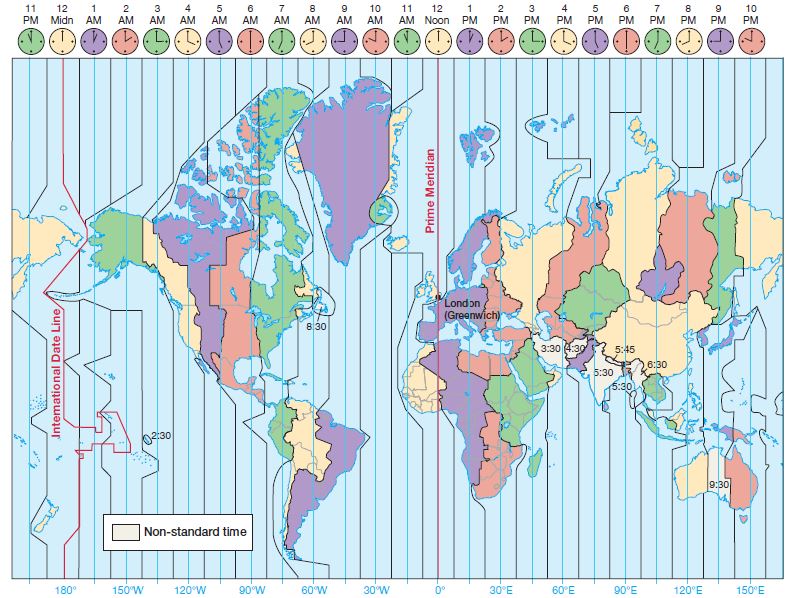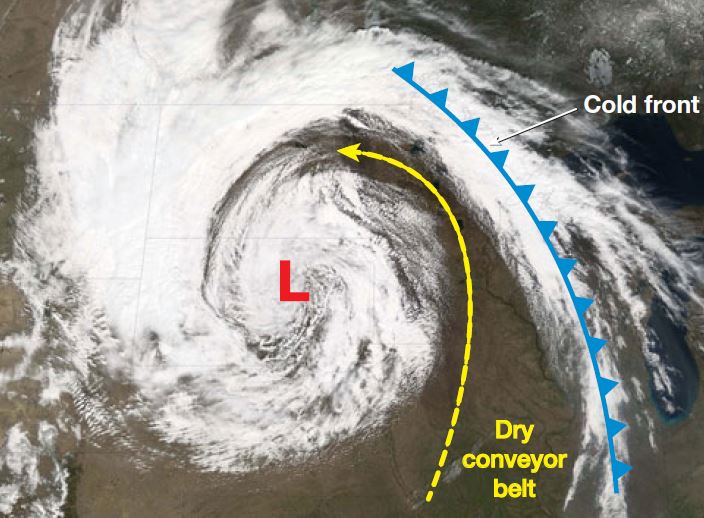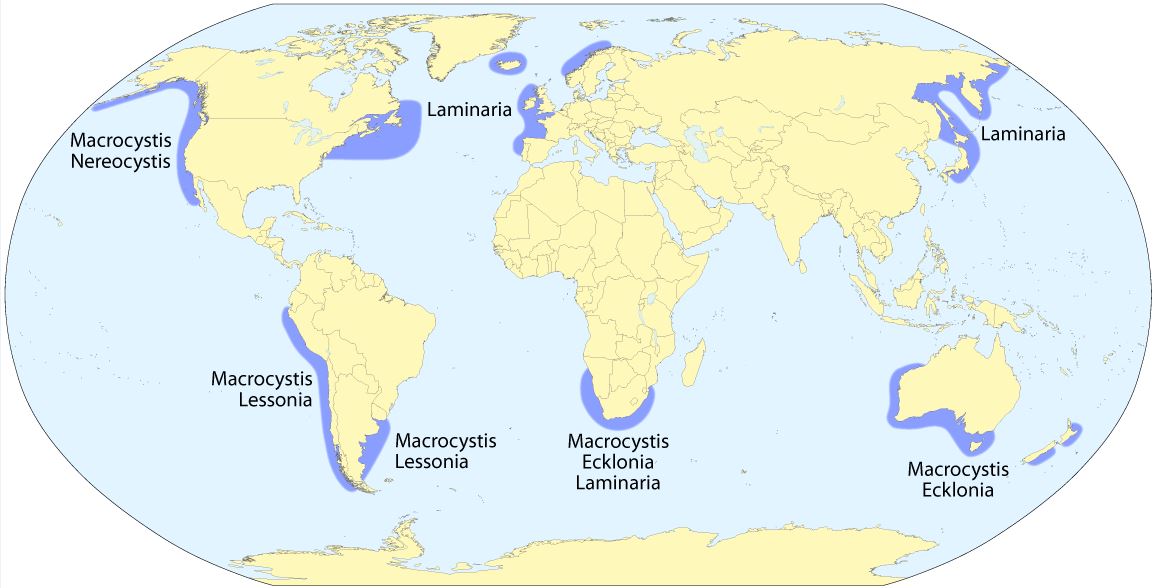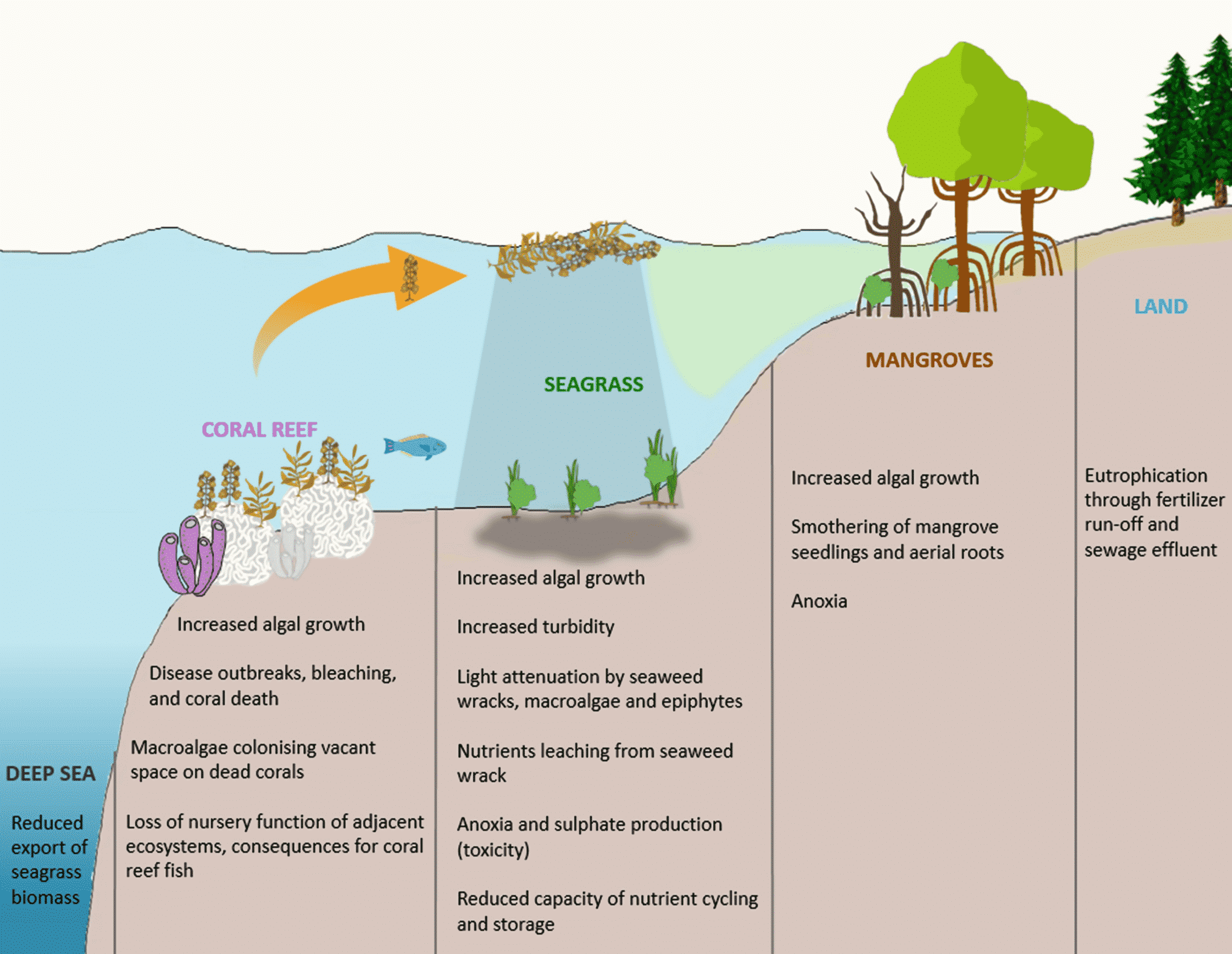Table of Contents
Time zones and International date line | UPSC – IAS
Comprehending time around the world depends on an understanding of both the geographic grid of latitude and longitude, and of Earth–Sun relations. As Malcolm Thomson, a Canadian authority on the physics of time has noted, there are really only three natural units of time:
- The tropical year, marked by the return of the seasons;
- The lunar month, marked by the return of the new moon; and
- The day, marked by passage of the Sun.
All other units of time measurement – such as a second, an hour, or a century—are human-made to meet the needs of society.
Image Explanation – The 24 time zones of the world, each based on central meridians spaced 15° apart. Especially over land areas, these boundaries have been significantly adjusted.
International Date Line | UPSC – IAS
In 1519, Ferdinand Magellan set out westward from Spain, sailing for East Asia with 241 men in five ships. Three years later, the remnants of his crew (18 men in one ship) successfully completed the first circumnavigation of the globe. Although a careful log had been kept, the crew found that their calendar was one day short of the correct date. This was the first human experience with time change on a global scale, the realization of which eventually led to the establishment of the International Date Line.
- One advantage of establishing the Greenwich meridian as the prime meridian is that its opposite arc is in the Pacific Ocean. The 180th meridian, transiting the sparsely populated mid-Pacific, was chosen as the meridian at which new days begin and old days exit from the surface of Earth.
- The International Date Line deviates from the 180th meridian in the Bering Sea to include all of the Aleutian Islands of Alaska within the same day and again in the South Pacific to keep islands of the same group (Fiji, Tonga) within the same day.
- The extensive eastern displacement of the date line in the central Pacific is due to the widely scattered locations of the many islands of the country of Kiribati. The International Date Line is in the middle of the time zone defined by the 180° meridian. Consequently, there is no time (i.e., hourly) change when crossing the International Date Line – only the calendar changes, not the clock. When you cross the International Date Line going from west to east, it becomes one day earlier (e.g., from January 2 to January 1); when you move across the line from east to west, it becomes one day later (e.g., from January 1 to January 2).
Standard Time | UPSC – IAS
At the 1884 International Prime Meridian Conference in Washington, D.C., countries agreed to divide the world into 24 standard time zones, each extending over 15° of longitude. The mean local solar time of the Greenwich (prime) meridian was chosen as the standard for the entire system. The prime meridian became the center of a time zone that extends 7.5° of longitude to the west and 7.5° to the east of the prime meridian. Similarly, the meridians that are multiples of 15° both east and west of the prime meridian, were set as the central meridians for the 23 other time zones
Although Greenwich Mean Time (GMT) is now referred to as Universal Time Coordinated (UTC), the prime meridian is still the reference for standard time. Because it is always the same number of minutes after the hour in all standard time zones (keeping in mind that a few countries, such as India, do not adhere to standard one-hour-interval time zones).
- To know the exact local time, we usually need to know only how many hours later or earlier our local time zone is compared to the time in Greenwich. Figure 1-31 shows the number of hours later or earlier than UTC it is in each time zone of the world.
- Most of the countries of the world are sufficiently small in their east–west direction so as to lie totally within a single time zone. However, large countries may encompass several zones: Russia occupies nine time zones; including Alaska and Hawai‘i, the United States spreads over six, Canada, six; and Australia, three.
- In international waters, time zones are defined to be exactly 7°30´ to the east and 7°30´ to the west of the central meridians. Over land areas, however, zone boundaries vary to coincide with appropriate political and economic boundaries. For example, continental Europe from Portugal to Poland shares one time zone, although longitudinally covering about 30°.
- At the extreme, China extends across four 15° zones, but the entire nation, at least officially, observes the time of the 120° east meridian, which is the one closest to Beijing.
Image Explanation – Times zones for Canada, the United States, and northern Mexico. The number in each time zone refers to the number of hours earlier than UTC (GMT).
In each time zone, the central meridian marks the location where clock time is the same as mean Sun time (i.e., the Sun reaches its highest point in the sky at 12:00 noon). On either side of that meridian, of course, clock time does not coincide with Sun time. The deviation between the two is shown for one U.S. zone in Figure 1-33. From the map of time zones of the United States (Figure 1-32), we can recognize a great deal of manipulation of the time zone boundaries for economic and political convenience. For example, the Central Standard Time Zone, centered on 90° W extends all the way to 105° W (which is the central meridian of the Mountain Standard Time Zone) in Texas to keep most of that state within the same zone. By contrast, El Paso, Texas, is officially within the Mountain Standard Time Zone in accord with its role as a major market center for southern New Mexico, which observes Mountain Standard Time. In the same vein, northwestern Indiana is in the Central Standard Time Zone with Chicago.
Daylight-Saving Time | UPSC – IAS
To conserve energy during World War I, Germany ordered all clocks set forward by an hour. This practice allowed the citizenry to “save” an hour of daylight by shifting the daylight period into the usual evening hours, thus reducing the consumption of electricity for lighting.
The United States began a similar policy in 1918, but many localities declined to observe “summer time” until the Uniform Time Act made the practice mandatory in all states that had not deliberately exempted themselves. Hawai‘i, and parts of Indiana and Arizona, have exempted themselves from observance of daylight-saving time under this act.
Image Explanation – Standard clock time versus Sun time. The Sun reaches its highest point in the sky at 12:00 noon in St. Louis and New Orleans because these two cities lie on the central meridian. For places east of the central meridian, the Sun is highest in the sky a few minutes before standard time noon; for locations west, local solar noon is a few minutes after. In Chicago, for instance, the Sun is highest in the sky at 11:50 A.M. and in Dallas it is highest in the sky at 12:28 P.M.
- Russia has adopted permanent daylight-saving time (and double daylight-saving time – two hours ahead of Sun time – in the summer).
- In recent years, Canada, Australia, New Zealand, and most of the nations of western Europe have also adopted daylight-saving time.
- In the Northern Hemisphere, many nations, like the United States, begin daylight-saving time on the second Sunday in March (in the spring we “spring forward” one hour) and resume standard time on the first Sunday in November (in the fall we “fall back” one hour).
- In the tropics, the lengths of day and night change little seasonally, and there is not much twilight. Consequently, daylight-saving time would offer little or no savings for tropical areas.













